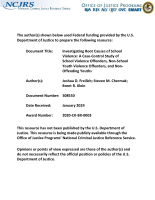Violence causes
Disputatiousness and the Offender-Victim Overlap
NIJ and HHS Violence Against Women Research Strategic Planning Workshop
Youth Violence, Guns, and Illicit Drug Markets
Examining the Dynamics of Serious Violent Incidents Among Inner-City, Adolescent, Public School Students in Atlanta, Georgia (From Trends, Risks, and Interventions in Lethal Violence: Proceedings of the Third Annual Spring Symposium of the Homicide Research Working Group, P 279-285, 1995, Carolyn Bl
Violence As Regulation and Social Control in the Distribution of Crack (From Drugs and Violence: Causes, Correlates, and Consequences, P 8-43, 1990, Mario De La Rosa, Elizabeth Y Lambert, Bernard Gropper, eds. -- See NCJ-128781)
Who's Right: Different Outcomes When Police and Scientists View the Same Set of Homicide Events, New York City, 1988 (From Drugs and Violence: Cause, Correlates, and Consequences, P 239-264, 1990, Mario De La Rosa, Elizabeth Y Lambert, Bernard Gropper, eds. -- See NCJ-128781)
Relationship Between Violence and Mental Disorder
Relationship of Mental Disorder to Violent Behavior, Summary of Findings
Relationship of Mental Disorder to Violent Behavior
Management of Inmate Violence: A Case Study Summary
Evaluation of the Chattanooga United to Reduce Violence (CURV) Initiative
Investigating Root Causes of School Violence: A Case-Control Study of School Violence Offenders, Non-School Youth Violence Offenders, and Non-Offending Youths
Explaining the Rise of Antisemitism in the United States
Cyber-Routines, Political Attitudes, and Exposure to Violence-Advocating Online Extremism
Lessons of an Honor Code: A Consideration of Conflict-Related Processes and Interpersonal Violence
Trauma, Trust in Government, and Social Connection: How Social Context Shapes Attitudes Related to the Use of Ideologically or Politically Motivated Violence
The interpersonal context of depression and violent behavior: A social psychological interpretation
The Social Anatomy of Adverse childhood Experiences and Aggression in a Representative Sample of Young Adults in the U.S.
Collective Efficacy and Violence in Chicago Neighborhoods: A Reproduction
Correlates of Violent Political Extremism in the United States
Race/Ethnicity and Measures of Violence at the Macro Level: Is Disadvantage Invariant Across Race-/Ethnicity-Specific Arrest, Victimization, and Offending?
Desistance from Crime: Interventions to Help Promote Desistance and Reduce Recidivism
No single criminal justice agency can promote desistance on its own. Partnerships across state, local, and federal agencies — along with the support of family and community stakeholders — are instrumental in supporting desistance from crime and reducing recidivism.
Law enforcement, courts, corrections, and community supervision agencies play a key role in the desistance process and reducing recidivism.
See the YouTube Terms of Service and Google Privacy Policy



